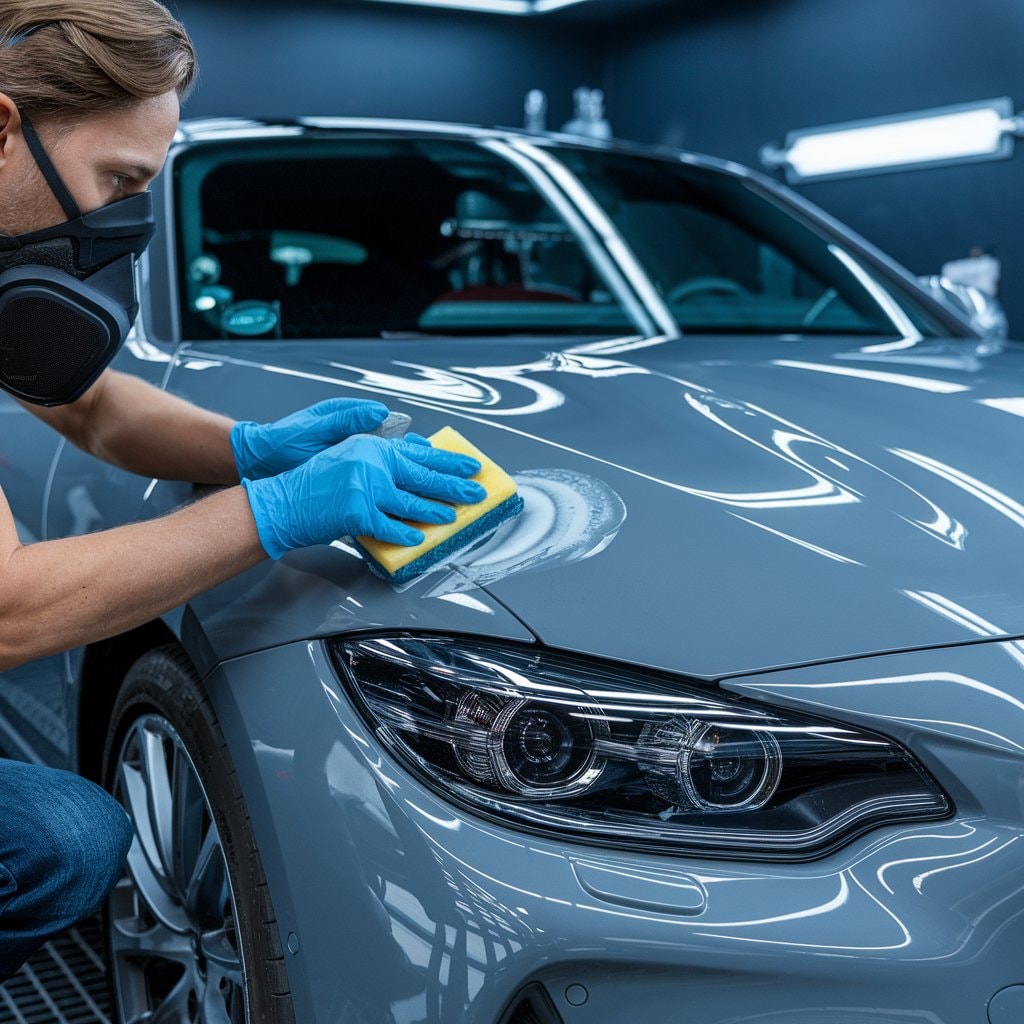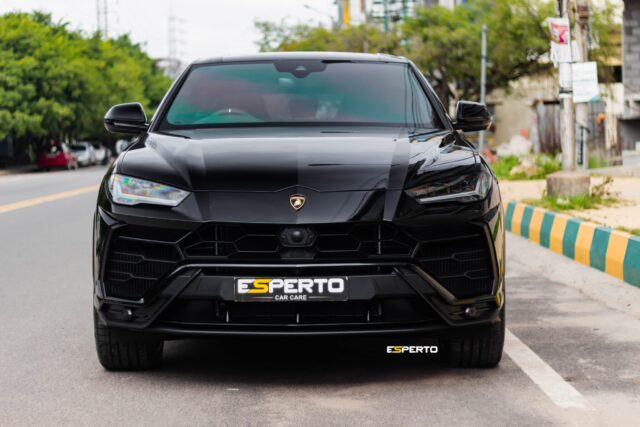Nano ceramic coating is a cutting-edge technology that utilizes nanotechnology to create a robust, protective layer on a car’s paint. It bonds chemically with the vehicle’s surface to form an impermeable barrier that defends against water, UV radiation, dirt, and harsh chemicals. This coating preserves the paint’s integrity and enhances the car’s aesthetic by maintaining its shine and color depth. For more insights, exploring further can reveal additional benefits and application tips.
How Does Nano Ceramic Coating Work?
Nano ceramic coating employs nanotechnology to provide a protective layer over a car’s paint, effectively shielding it from environmental damage.
This coating bonds at a molecular level, creating an impermeable barrier against water, dirt, and UV radiation.
Using such a coating preserves the vehicle’s aesthetic appeal and enhances its durability.
How Does Nano Ceramic Coating Work?
Ceramic coating employs nanotechnology to provide a protective layer over a car’s paintwork. It utilizes nanoparticles that bond chemically with the vehicle’s surface.
This nano-ceramic coating is a robust barrier protecting the vehicle’s paint from harsh chemicals, UV rays, and minor scratches, which typically diminish a car’s aesthetic and functional integrity.
Its enhanced durability overcomes the limitations of traditional paint protection films by offering a more vigorous defense against environmental aggressors.
Furthermore, the ceramic coating’s hydrophobic properties make the car’s paint highly resistant to water, causing droplets to bead up and roll off the surface, thereby reducing dirt and grime buildup.
This seamless shield not only maintains the vehicle’s pristine appearance but also extends the life of the paintwork.
How Does Coating Work to Protect Your Car?
Understanding the protective mechanism of nano ceramic coating starts with its composition. Unlike traditional paint sealants, this advanced solution bonds molecularly with the car’s exterior, forming a durable shield.
This layer protects against various environmental factors that typically degrade vehicle surfaces. Nano ceramic coating excels in repelling water and oils, reducing the risk of stains and etching.
It also protects against UV damage, blocking the harsh rays that can fade and crack paint over time. By creating an impermeable barrier, ceramic coatings provide long-term protection, preserving the integrity and appearance of the vehicle’s exterior effectively and efficiently.
Advantages of Using Nano Ceramic Coating
Building on the foundational knowledge of how nano ceramic coating functions to protect a car’s surface, it is equally important to explore the specific advantages it offers to vehicle owners.
Nano ceramic coating protects by adding a robust layer to the car’s surface, shielding it from environmental hazards and minor abrasions. This coating guarantees a high gloss finish, enhancing the vehicle’s aesthetic appeal with a glossy finish that maintains the car in pristine condition.
The enhanced gloss and protection also minimize the need for frequent detailing, leading to minimal maintenance. Overall, nano ceramic coating offers a compelling combination of beauty and protection, making it an invaluable investment for maintaining a vehicle’s appearance and integrity over time.
Types of Ceramic Coating
The variety of nano-ceramic coatings encompasses several types, each with distinct advantages and compositions.
A key advantage of ceramic-based nano coatings is their enhanced durability and protection against environmental elements.
Exploring carbon-based nano coatings reveals their unique properties and applications in automotive protection.
What Are the Types of Nano Ceramic Coating?
Nano ceramic car coatings vary widely in composition and performance, catering to different protective needs and budgets. Ceramic coating products, come in various formulations, each offering unique benefits. The 9H ceramic coating, known for its high hardness rating, provides excellent scratch resistance. Users often choose between DIY ceramic coating kits and professional-grade options when applying nano ceramic coatings.
| Type | Key Feature |
|---|---|
| 9H Ceramic Coating | High hardness, superior scratch resistance |
| DIY Ceramic Coating | Cost-effective, user-friendly application |
These types of nano ceramic help maintain the aesthetic and structural integrity of vehicles, adapting to diverse consumer needs and preferences in car coating.
What is a key advantage of ceramic-based nano coatings?
One key advantage of ceramic-based nano coatings is their exceptional ability to provide long-lasting protection against environmental hazards.
These coatings, primarily made from silicon dioxide and liquid polymer, bond with a car’s paint at a molecular level, enhancing the clear coat. This fortified layer is more resistant to scratches and chemicals and repels water and UV rays, consequently preserving the car’s surface.
The durability of nano ceramic coating means there is less need for paint correction, maintaining the aesthetic and resale value of the vehicle.
Ultimately, the robust ceramic paint coating acts as a shield, enhancing the protection of your car against the elements, thereby extending the life and beauty of its exterior.
Carbon-Based Nano Coatings: An Overview
Carbon-based nano coatings represent a sophisticated class of ceramic coatings distinguished by their incorporation of carbon nanoparticles.
These nano coatings have evolved considerably within the car care industry, offering a robust alternative to traditional car wax. Unlike other types of coating, carbon-based nano coatings provide enhanced durability and protection.
Their unique composition often includes titanium dioxide, contributing to their superior UV resistance and hydrophobic properties. This type of coating is particularly favored by car enthusiasts looking for long-term solutions, a prominent example of a nano-ceramic coating that promises increased scratch resistance and gloss retention.
Such advancements position carbon-based nano coatings as a pivotal development in paint coating technology.

What Makes the Best Ceramic Coating?
Identifying the best ceramic coating for cars involves evaluating various criteria and understanding key features that enhance vehicle protection.
Factors such as durability, ease of application, and resistance to environmental elements are essential in selecting the most effective product.
A thorough analysis of these factors helps car owners choose a ceramic coating that offers maximum protection and longevity.
Criteria for Selecting Ceramic Coating Products
When selecting the best ceramic coating for cars, several key criteria must be considered to guarantee peak performance and durability.
It’s vital to evaluate the variety of coatings available on the market. A high-quality ceramic coating offers robust protection against environmental factors.
The composition of the coating is significant; understanding how it is made can influence its effectiveness and longevity.
Additionally, consider the specific coating needs of your vehicle and how well the nano-ceramic coating adheres to its surface.
The ceramic coating cost should also align with the expected performance benefits.
Finally, the ease with which you can apply the coating and how uniformly the coating is applied are important factors.
Key Characteristics of Top-Quality Ceramic Coating for Cars
As car enthusiasts seek the ultimate protection for their vehicles, understanding the distinctive features of the best ceramic coatings becomes essential.
The top nano ceramic coatings are a great solution for preserving the factory paint of a vehicle by forming a hard, resilient layer over the car’s surface. This barrier maintains a shiny car appearance and protects the paint from swirl marks, minor scratches, and contaminants.
Ideal coatings enhance the depth and clarity of the car’s paint, ensuring it looks vibrant and new. Additionally, the hydrophobic properties of these coatings make the surface of your car easier to clean, as they repel water and dirt, preventing staining and etching on the paint surface.
Choosing the Ideal Ceramic Coating for Maximum Protection
Selecting the ideal ceramic coating requires understanding its chemical properties and the level of protection it offers. Nano ceramic coating is a key innovation in car care, enhancing the resilience of a car’s paint. When ceramic coatings are applied, a durable coating forms on the car’s surface, safeguarding it from environmental elements and minor abrasions.
| Feature | Benefit | Importance |
|---|---|---|
| Chemical Resistance | Protects against acidic contaminants | High |
| UV Resistance | Prevents paint fading | Medium |
| Thickness | Enhances scratch resistance | High |
Car owners should choose a ceramic coating that balances these features to protect their cars effectively. This guarantees the surface remains pristine and reduces ongoing maintenance needs.
Understanding the Science Behind Nano Ceramic Coated Cars
Nano ceramic coatings serve as a protective barrier, enhancing the surface durability of cars against environmental damages such as scratches and UV radiation.
However, misconceptions persist regarding their capabilities and limitations.
This section will clarify how these coatings function and address common myths surrounding their application on vehicles.
How Nano Ceramic Coatings Enhance Surface Protection
Understanding how nano ceramic coatings enhance surface protection begins with recognizing their molecular structure.
Nano ceramic coating, applied to the surface of a car, utilizes nanotechnology to form a resilient layer that bonds tightly with the car’s paint. This molecular bond creates a durable shield, considerably enhancing the car’s surface protection against environmental contaminants and minor abrasions.
The benefits of ceramic coatings extend beyond mere aesthetics; they also contribute to the longevity of the paint by guarding against UV damage and oxidation.
The ceramic coating makes the vehicle easier to clean, repelling water and dirt. Consequently, adding a coating to your car helps protect it and maintain its pristine appearance.
Debunking Myths About Ceramic Coating Cars
The detailing world often touts nano ceramic coating as a panacea for all car surface issues, which leads to misconceptions.
Here are key myths debunked:
- Nano ceramic coating is scratch-proof: It greatly enhances the car’s paint durability but is not impervious to all scratches.
- No need for washing: While it offers superior protection against bird droppings and environmental conditions, proper care and regular cleaning are still necessary.
- Permanent application: The coating on the car degrades over time and will require reapplication depending on the car’s usage and maintenance.
Understanding these points guarantees that your expectations about nano ceramic coatings’ aesthetic appeal and protection level are realistic.
Is Ceramic Coating Worth the Cost?
Evaluating whether the ceramic coating is prudent involves comparing initial outlay against potential long-term advantages.
This analysis helps determine if it is merely an expense or an investment in maintaining a vehicle’s aesthetic and structural integrity.
The following discussion will provide a conclusive viewpoint on the overall value of ceramic coatings for cars.
Initial Ceramic Coating Cost vs Long-term Benefits
Although the initial cost of applying a nano-ceramic coating to a car can be high, varying from a few hundred to over a thousand dollars, depending on the quality and brand, the long-term benefits—such as reduced maintenance costs, enhanced protection from environmental damage, and preservation of the vehicle’s aesthetic appeal—often justify the upfront investment.
- Enhanced Durability: Nano ceramic coating shields the car’s paint from UV rays and chemical stains.
- Lower Maintenance: The coating’s hydrophobic properties make cleaning more manageable and less frequent.
- Preservation of Value: Protecting the car’s surface helps maintain its resale value.
These factors lead to the final verdict on ceramic coatings. For many, it’s a worthwhile investment, providing substantial protection for your car’s paint and contributing to long-term benefits.
Ceramic Coating: Investment or Expense?
While considering the sizable initial cost of nano ceramic coating for cars, it is essential to assess whether this expense qualifies more suitably as an investment. Ceramic coating offers a robust protective layer for a car’s paint, shielding the surface from scratches and environmental contaminants. This preservation helps keep the vehicle in tip-top shape, potentially increasing its resale value.
| Aspect | Expense vs. Investment |
|---|---|
| Protection Level | High Investment |
| Durability | Long-term Expense |
| Resale Value | Potential Investment |
Considering the cost of ceramic coating against the benefits of extended paint life and enhanced appearance, whether it’s an investment or an expense, leans towards it being a worthwhile investment to protect your car.
The Final Verdict on Ceramic Coatings
Given the analysis of costs versus benefits, the final verdict on whether the ceramic coating is worth the investment hinges primarily on the owner’s value on vehicle maintenance and appearance.
Nano ceramic coating acts as an invisible shield for a car’s paint, preserving the aesthetic and structural integrity of the car’s surface.
- Durability: Ceramic coatings offer protection against extreme temperatures, harsh chemicals, and UV rays.
- Maintenance: The slick ceramic surface reduces the need for frequent washes, helping to keep your car cleaner for longer.
- Appearance: Provides a high-gloss finish that enhances the paint’s vibrancy.
Ultimately, if the priority is to protect your car while minimizing upkeep and preserving its look, the final verdict on ceramic coatings leans toward a valuable investment.

Conclusion
In summary, nanoceramic coating offers a cutting-edge solution to protect a car’s exterior using nanotechnology to provide a durable shield against environmental elements. While various coatings exist, understanding their composition and benefits is essential. Although the initial cost might seem high, the long-term protection and reduced maintenance costs may prove cost-effective. Ultimately, whether the ceramic coating is worth the investment depends on individual car maintenance and care priorities.






